I am not an expert on I2, I2-Y3120 or a subject matter expert on ancient tribes. If anything, I'm an expert on geographically peripheral J2b-L283. I am only looking at I2-Y3120 through the prism of geolocated samples on the YFull tree and the estimated TMRCAs.
I can't believe that 1.5 years have passed since I first wrote about this much discussed lineage I2-Y3120.
I wrote that post shortly before I released the Diversity Heatmap (FAQ).
I decided to take another look at this interesting lineage using some of my newly developed tools, some still under development and soon to be released.
I now feel that in my original post, I may have overlooked the possibility of a Dacian tribal origin for this lineage because I was unfamiliar with Dacian history.
Widespread Diversity
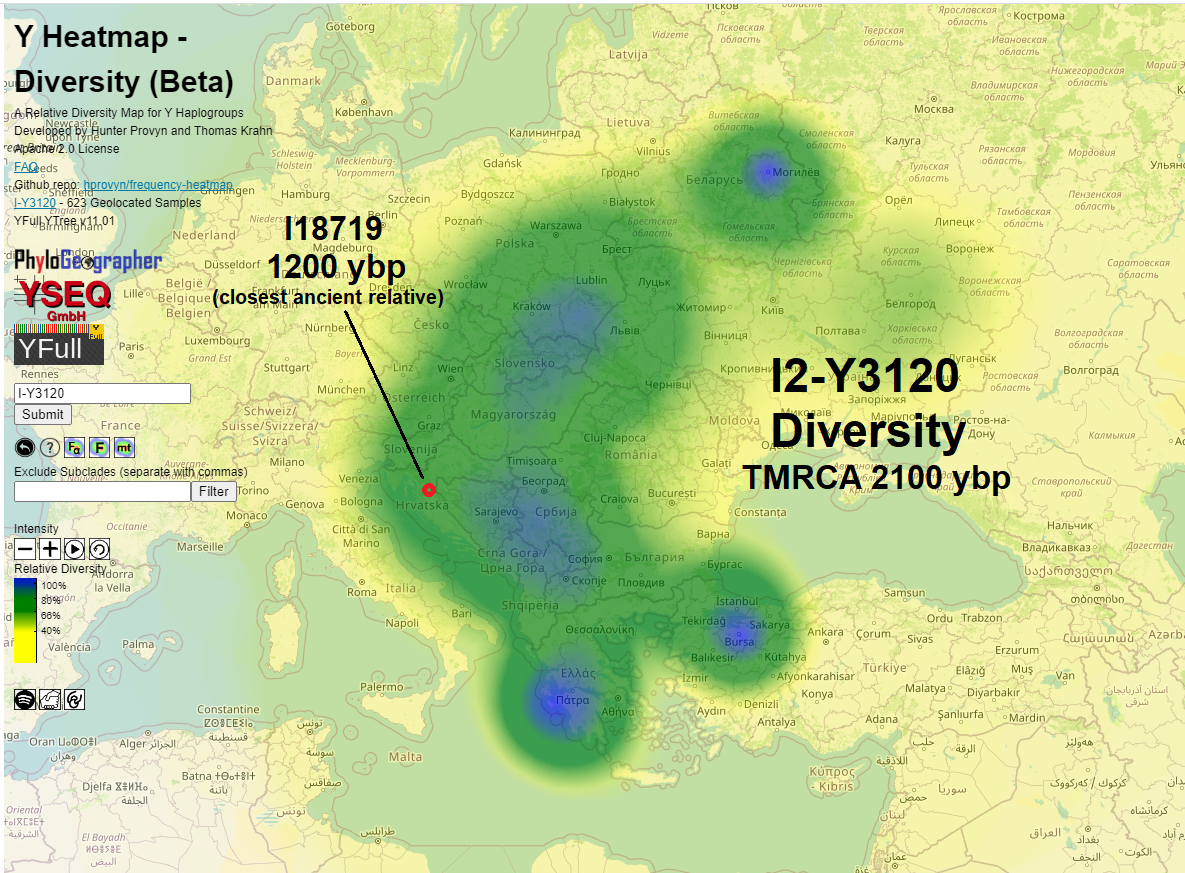
There are different ways diversity can be measured, and I explain the methodology used by Diversity Heatmap in the FAQ. Diversity Heatmap takes regional sample rate into account.
Interestingly, I2-Y3120 exhibits diversity over a relatively large area. The central-most areas exhibiting high diversity form a roughly boomerang-shaped region with one peak in the Carpathians of Poland and Slovakia and another in the Dinaric Alps of Bosnia, Serbia, Montenegro and Kosovo.
Diversity Heatmap, based on the geolocated samples on the YFull YTree, does not compute Ukraine as an area of high diversity for I2-Y3120. I mention this because I have heard that some older studies based on STRs indicate Ukraine as having higher diversity.
Centroids Computed Around Romania
Most of I2-Y3120's six child lineages' centroids are computed to within the aforementioned area of greatest diversity. I2-Y3120 itself has a centroid computed to the northwest of modern Argeș county. This is because it is a central location among the centroids of its children.
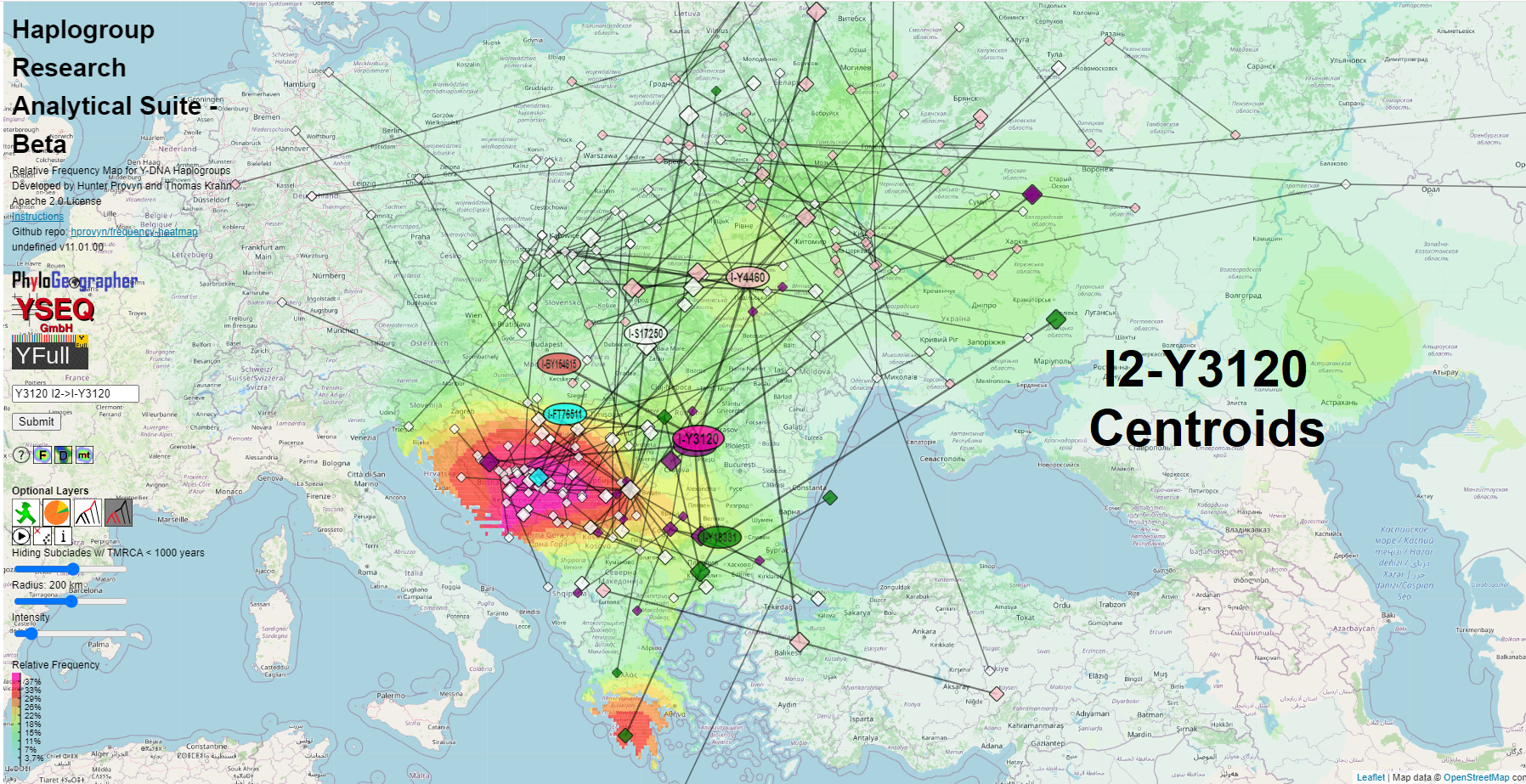
I include screenshots from the Haplogroup Research Analytical Suite I am currently developing together with Thomas Krahn. This tool allows you to designate countries as outliers and then recomputes the centroids on-the-fly.
Distant outliers usually pull the centroid in their direction to some extent, even though my algorithm computes a centroid not in the strictly traditional sense (i.e. average of positions), but as the average of the weighted centroid (strictu senso) and the position from the set of downstream nodes which minimizes distance to all other nodes weighted by downstream node TMRCA and giving additional weight to ancient samples. I will wait until the tool is released to provide the exact details, as they may change.
I will note that these screenshots use a version of centroid calculation that does not use regional sampling rate as an additional factor. I plan to make the algorithm take this into account, if not by the time the tool is initially released, then in a future update.

In the case of I2-Y3120, I decided to exclude samples from Russia, Finland, Sweden, Estonia, Latvia and Lithuania because these samples are far from the centers of diversity. The effect of removing these outliers was not drastic but I have more confidence in the result.
That being said, neither Diversity Heatmap nor these centroid computations are guaranteed in any particular case to indicate the origin of a haplogroup.
These tools are meant to be used to visualize geospatial sample data as part of a multi-disciplinary approach to investigate haplogroup origins.
I now include the screenshot for I2-PH908 to show that about 84% of the peak I2-Y3120 frequency in Bosnia and Serbia comes from the offspring of a single man, I2-PH908 who lived about 1700 years ago.
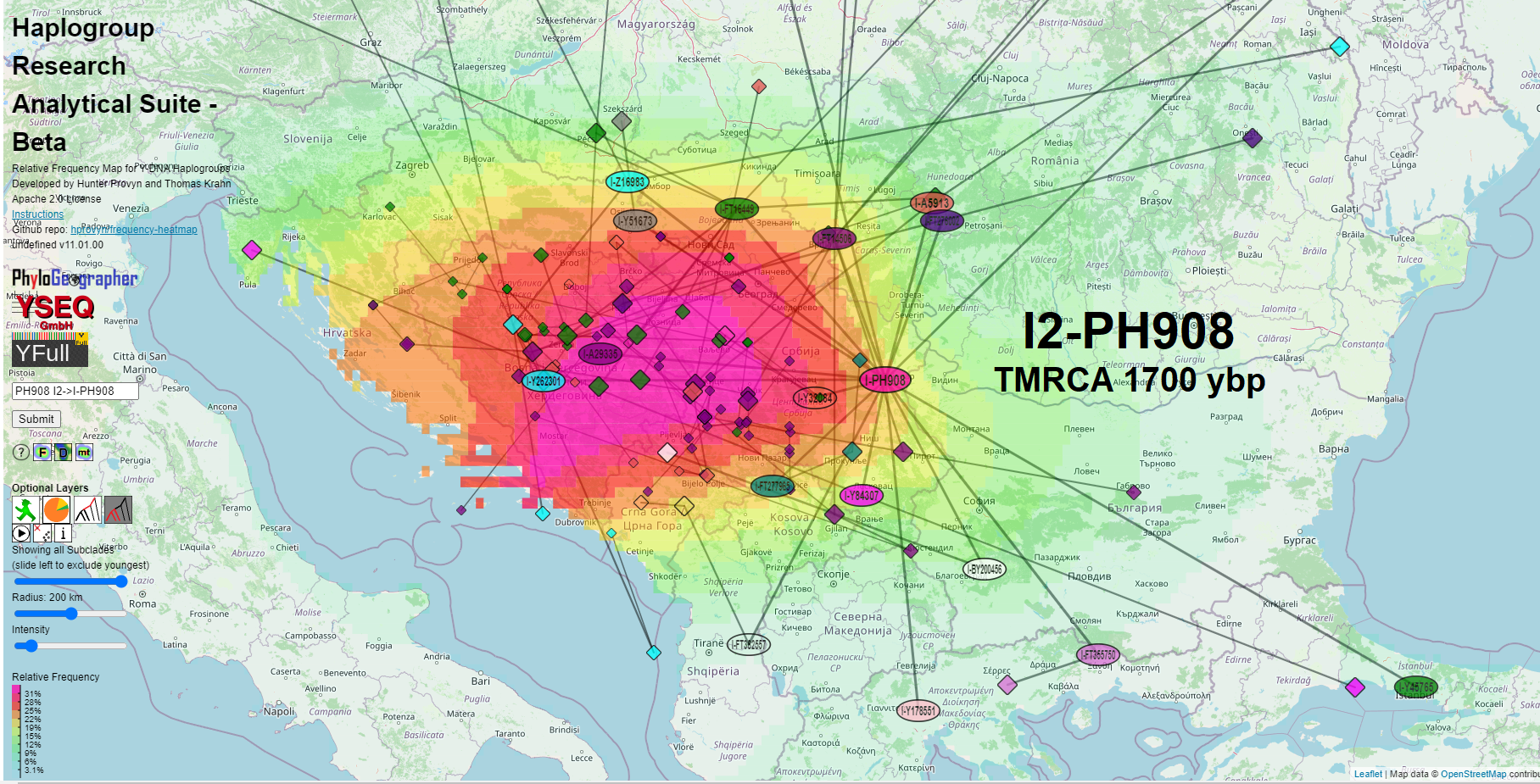
I2-Y3120's Sibling - Ancient I18719
I'm not aware of any older ancient samples than the 1200 ybp samples from South Moravia, Czechia and Bursa, Turkiye.
In that case we should look at where I2-Y3120's siblings are found.
There is an ancient sample on the YFull YTree with low coverage that is designated as either I2-CTS10228 or a kind of I2-Y3120 (though his age significantly predates the TMRCA). The coverage is very low at 2x but the age makes the sample interesting.
YFull has the sample as 3200 ybp. I will note that his female line is in subclade HV0a1a1b with a much more recently computed TMRCA of 225 years according to MTree 1.02.19113. I have heard from another researcher that people doubt the age of this sample is really 3200 years but I do not think this young MTree estimate alone is proof of some sort of mistake, because MTree TMRCAs are in beta and not as reliable as those on the YTree.
Please feel free to contact me or post as a comment a link to some opinion regarding the provenance of this sample.
All I know is that, in my experience with J2b-L283 research, the people who doubt the provenance of ancient samples are generally motivated reasoners.
Assuming that the sample really is 3200 years old, then the true geographic origin of I2-CTS10228 (or whatever subclade he may actually be, were his coverage high enough) may have been near Vrhovine, Croatia given that he lived only about two hundred years after the I2-CTS10228 TMRCA.
I2-Y3120 Lacks Roman-mediated Migration to England or the Rhine
I am however skeptical that I2-Y3120 itself may have arisen in Croatia. The modern distribution lacks the pattern of likely Roman-mediated migration to the Rhine or England that J2b-L283 lineages from this area exhibit.
Of the two oldest lineages that settled within areas controlled by Rome:
- I2-PH908 in Bosnia / Serbia - the TMRCA is 1700 ybp so they may not have been living there during the period that Roman was in control and recruiting there
- I2-Y18331 in Greece - I have not found many references of Romans recruiting Greeks to serve as auxiliaries or legionaries.
I2-Y3120's Sibling - I2-Y81696
The TMRCA of 1600 ybp and being found in Baden-Wuerttemberg and Bas-Rhin, in my opinion, is not a reliable indicator that the deeper origin of this line came from the area. I say this based on the research of my own haplogroup J2b-L283 that has many lineages found in that area now that are proven by ancient DNA to not have originated there.
This line could also possibly have migrated to the Upper Rhine area due to a Roman-mediated migration or some other Migration Period population movement.
If I2-Y3120 really did originate in a Dacian dynasty, and I'll get to them next, then we might consider I2-CTS10228 as a Balkan remnant whose line barely survived the J2b-L283 expansion (and other regional challenges) and who did reasonably well in reproducing around 1400 BCE.
The Dacians
I find that some of the circumstantial information regarding I2-Y3120 matches aspects of Dacian history. Modern historians appear to prefer the term Geto-Dacian but I have just used the term Dacian for simplicity here.
I recommend reading the Wikipedia article on Dacians, it is concise and interesting.
To paraphrase, there were Dacian kings before Burebista, dating back to 450 BCE, but only after subsequent contact and influence from the Celts was their new La Tene-based economy able to facilitate the consolidation of political power through tribal unions.
The estimated TMRCA of 100 BCE is very close to this period of consolidation of power of the Dacian monarchy.
Burebista's accession came with the expulsion of Celts around 60 BC when his forces moved through to the middle Danube region, and with the support of the religious establishment and leaders in Dacia which brought around a stricter moral code in the Dacian kingdom.[5][7] Around this time the pottery of the Dacian style began appearing in Celtic settlements in Central Europe, including the area covered by the former Yugoslavia, especially in Gomolava, Yugoslavia, and Budapest, Hungary. - Burebista on Wikipedia
The Dacians are believed to have defeated the Scordisci, who were the dominant tribe of the northwestern Balkans at that time.
So if I2-Y3120 were Dacian, some of them may have migrated to these centers of modern diversity and higher frequency as far back as the reign of Burebista 60 BCE.
Burebista became Rome's enemy by siding with Pompey (spoiler alert - he lost) but before a war broke out he was assassinated by his own noblemen.
After his death, the kingdom was split into four and then five parts, with the original power center confined to the Orăştie Mountains (Bunson 2014)
I2-S17250 Through a Dacian Prism would be Decebalus
I'll copy an excerpt from my 2021 article that is still valid:
If you look at how many SNPs comprise each of I2-Y3120 child lineages, you can infer the following:
- He had three sons* that were the most successful in terms of being prolific, I2-Y18331, I2-Z17855, I2-Y4460
- A fourth son was not as prolific himself, but several generations later, one of his line founded a new dynasty, I2-S17250.
- Through this dynasty, the fourth son would ultimately have more descendants than all the rest of his siblings put together
(note two lines I am not mentioning here with longer bottlenecks followed by less growth - I2-BY154615 and I2-FT76511)
The fourth son, fourth in enumerating as we do not know the sequence of birth or whether each SNP in fact represents several successive generations during which only a single SNP accumulated, had five child lineages.
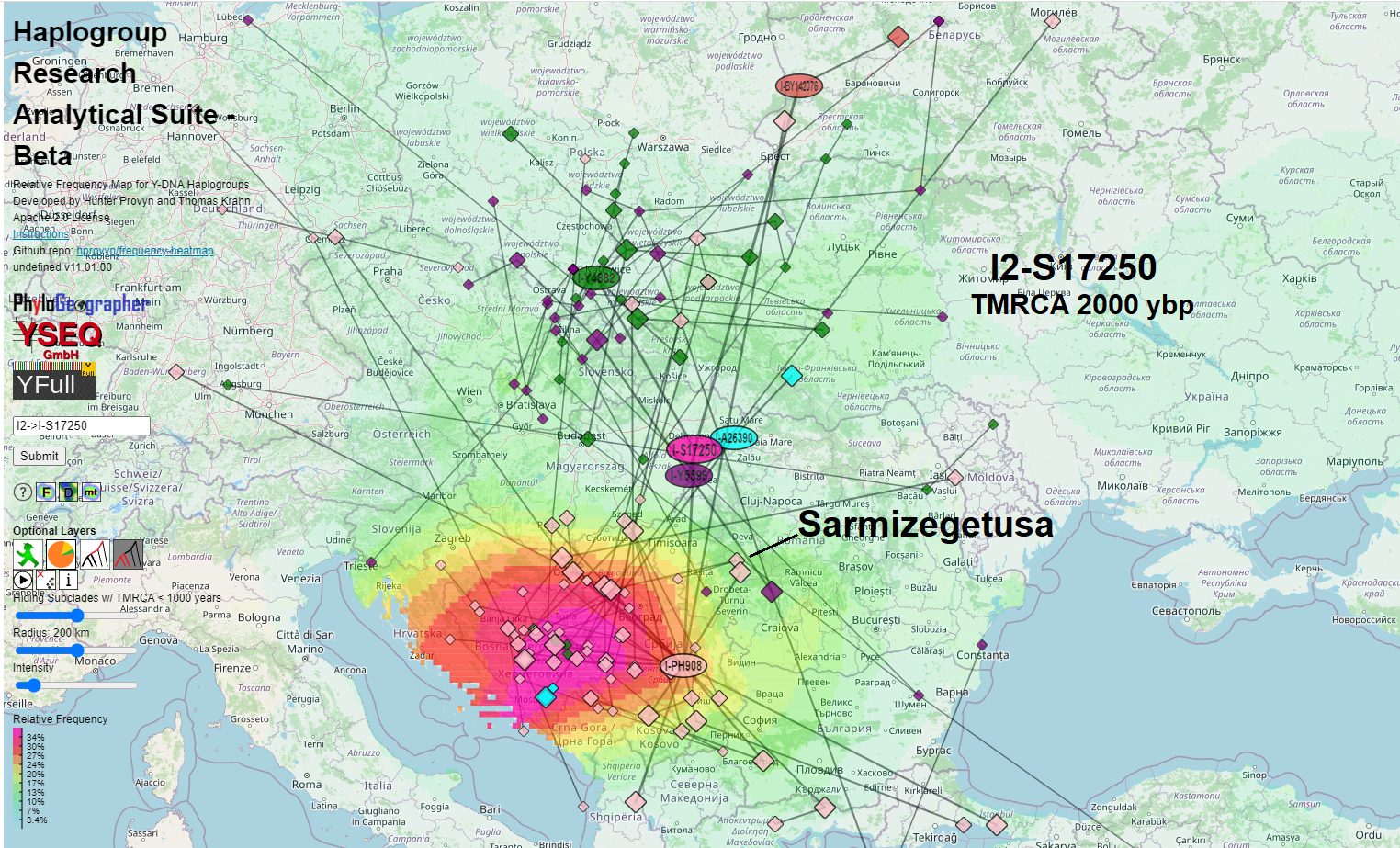
It is worth noting that some of the oldest I2-Y3120 found in South Moravia, however unfortunately not old enough to preclude various theories of when it arrived there, is only found in two lines of I2-Y3120, namely I2-Y5596 and I2-Y4882 which are children of I2-S17250
So if our attributions of I2-Y3120 to Burebista and I2-S17250 to Decebalus are correct, then this would indicate that the 1200 year old ancient samples in South Moravia were not migrants during the period of Burebista's conquest of the Boii and Taurisci, but may have migrated there later.
What about Celts and Slavs?
The interesting thing about a Dacian theory is that it doesn't shut the door on either of:
- Possibility that I2-Y3120's deeper origins are Celtic from Central Europe
- Possibility that some lines joined migrating Slavs and Slavicized before migrating to their final destination
To learn more about the former, we would need to break the I2-Y3120 bottleneck from 3400 to 2100 ybp. However if the 3200 year old ancient I18719 is legit (and as I said I have no evidence that it is not), then I think it makes more sense to view I2-CTS10228 as having been a Proto-Illyrian/Dacian/Thracian lineage in 1400 BCE.
To definitively learn more about the latter, we would need ancient samples dating to before the Slavic migrations to the Balkans. Again I18719 is key because it shows that the lineage's closest sibling was living in future Slavic Croatia nearly two millennia before the arrival of Slavs.
I2-Y18331 Overwhelming Diversity in Greece
The diversity of this one particular line of I2-Y3120 in Greece is so great, that it even contributes significantly toward Greek diversity of parent I2-Y18331, the calculation of which takes five other sibling lines into account, which have significantly less representation in Greece and those lines in Greece having younger TMRCAs.
The samples of some of these other lines of I2-Y3120 represented in Greece contain hints on the YFull YTree of a more recent migration to Greece from somewhere else, for instance "mkd" Macedonian, "blg" Bulgarian, and "pnt" Pontic language codes.
However there is overwhelming circumstantial evidence that I2-Y18331 originated in Greece. Otherwise it was a massive later co-migration almost exclusively to Greece proper leaving no trace of where it came from and siring no children along the way.
One of the few child lineages with non-Greece modern distribution, I2-Y23115, has a TMRCA of 1100 years ago. I was told by another researcher that these men all have oral traditions of being eastern Ashkenazi.
Given the context of overwhelming diversity in Greece dating to 100 BCE, this Ashkenazi line may have originally been Greek Jews. History of Jewish settlement in Thessaloniki may stretch back 2000 years, according to Wikipedia.
Looking at I2-Y18331 through a Dacian prism, this line may represent a son or descendant of Burebista who came into contact with the Greeks. Burebista conquered and annexed the Greek fortresses along the Black Sea coast from Olbia to Apollonia but I find no mention of raids or conquests into Greece proper.
There is an interesting Greek figure named Akornion, an important citizen of the Ionian Greek colony of Dionysupolis (modern Balchik). An inscription there dating to 48 BCE describes Akornion as the "first and greatest friend" of Burebista (Oltean 2007). As Burebista's ambassador, Akornion convinced Pompey to accept Burebista's support.
I find this reference to the meeting place by googling from jstor (F Millar 1984):
When the king took him as a confidant and sent him as an ambassador to Pompey, encamped at. Heraclea Lyncestis in northern Greece in 49-8 B.C
So some of what I consider most likely explanations for this line becoming Greeks now living in Greece proper include:
- Demic diffusion of Hellenized Dacians from conquered Black Sea coastal colonies
- Dacian bodyguard of ambassador Akornion may have accompanied him to meet Pompey at then Greek Heraclea Lyncestis (modern Bitola, N Macedonia)
- A son of Burebista may have sealed a political alliance with a friend or family member of Akornion through marriage to a Greek woman. A higher social status can help explain the higher reproductive fitness of this line in 100 BCE.
Rgarding Heraclea Lyncestis, this town was later abandoned by Greeks following an earthquake and Slavic invasions.
What about the Russian Flag Samples?
There is a lot of diversity of geography and ethnicity in the samples who have marked paternal descent to somewhere in Russia.
Thankfully, 72 of the 76 samples with Russia country code have a more specific regional code.
I calculated some quick statistics comparing the Russian regional code distribution of I2-Y3120 with R1a-L1029, the latter being an examplar of what we would expect for a Proto-Slavic tribe.
I found a similar proportion of Russia samples (about 1/8) tracing descent to Tatarstan in both. I share this information just out of curiousity. It didn't help me reach any conclusions.

It is easier to see differences in regional distribution in the heatmap.
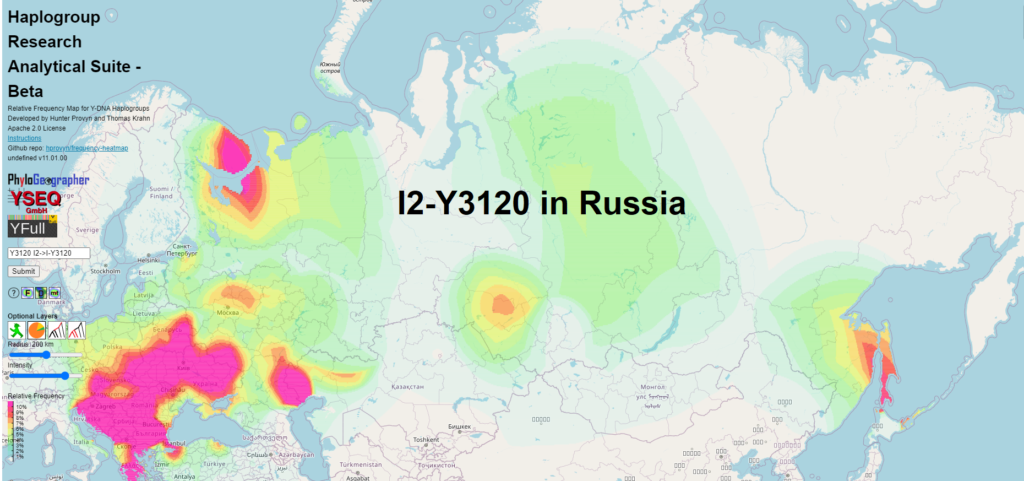
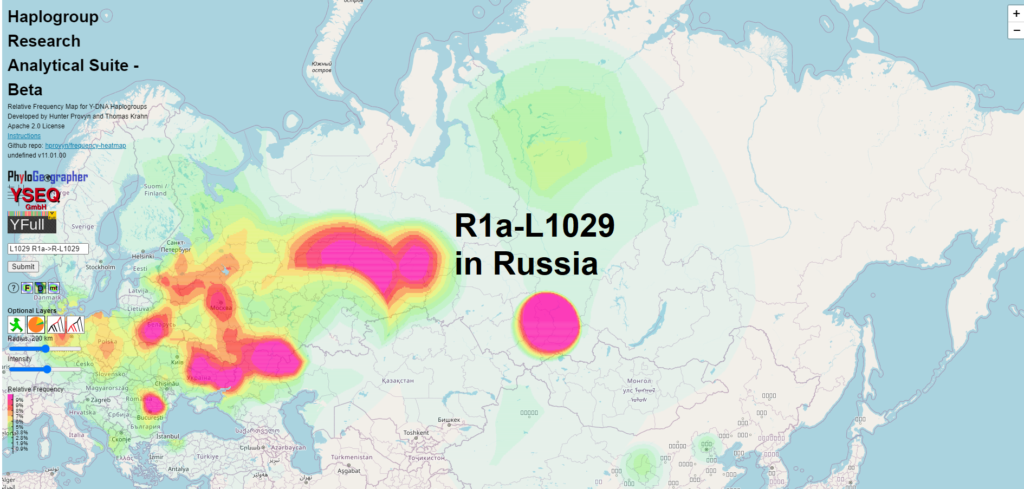
Two things are clear by comparing the relative frequency maps.
- Much more of R1a-L1029 ended up within Russia vs elsewhere as copmared to I2-Y3120.
- There is much less representation of I2-Y3120 within the Grand Duchy of Moscow relative to R1a-L1029.
Did the Romans and/or R1a-L1029 displace/replace I2-Y3120 in Romania?
R1a-L1029 having displaced/replaced I2-Y3120 in Romania could help to explain why:
- I2-Y3120 is found less in Russia
- R1a-L1029 has a peak in Romania
- I2-Y3120 has a relative hole in Romania
Note that Romania and Moldova are still undersampled relative to their neighbors. There is more that we can learn.
I left out the terms for ethnic groups Dacian or Slav here because by the time of the Slavic migrations these older haplogroups may have taken on any number of ethnic identities, dictated by their geography and the shifting political alliances.
Another reason for the I2-Y3120 hole in Romania is destruction of Dacian men and power centers by Trajan followed by Roman colonization.
One hundred thousand male slaves were sent back to Rome; and to discourage future revolts, legions XIII Gemina and V Macedonica were permanently posted in Dacia. - from Trajan's Dacian Wars but not attributed
By the way only one sample from Italy on YFull could possibly descend from a Dacian slave sent to Rome at that time, in this branch I2-FT277965.
The other three samples from Italy are all too closely related (within 1000 years) to men from Bosnia, that such an early migration to Italy can be ruled out.
Thracians
If I2-Y3120 were actually Dacians, we might eventually expect to find some relatives, perhaps splitting the bottleneck, in the burials of the neighboring Thracian Odrysian kingdom.
Many elite burials with golden funeral masks have been recovered by archaeologists, yet I find no Iron Age male samples from Bulgaria on the YFull tree yet.
I would not be surprised to find some ancient J2b-L283 in samples from the Odrysian kingdom.
Addendum 3/6/2023
Regarding the ancient sample I18719, I will be willing to send a link to my contacts at YFull to a subject matter expert's best arguments for why this sample's 3200 ybp age should not be accepted on the YFull tree.
The argument should not consist of theories about the origin of this lineage because the theories should proceed from the samples, not vice versa.
Now for some additional maps and diversity metrics per country.
Diversity of I2-Y3120 by Country
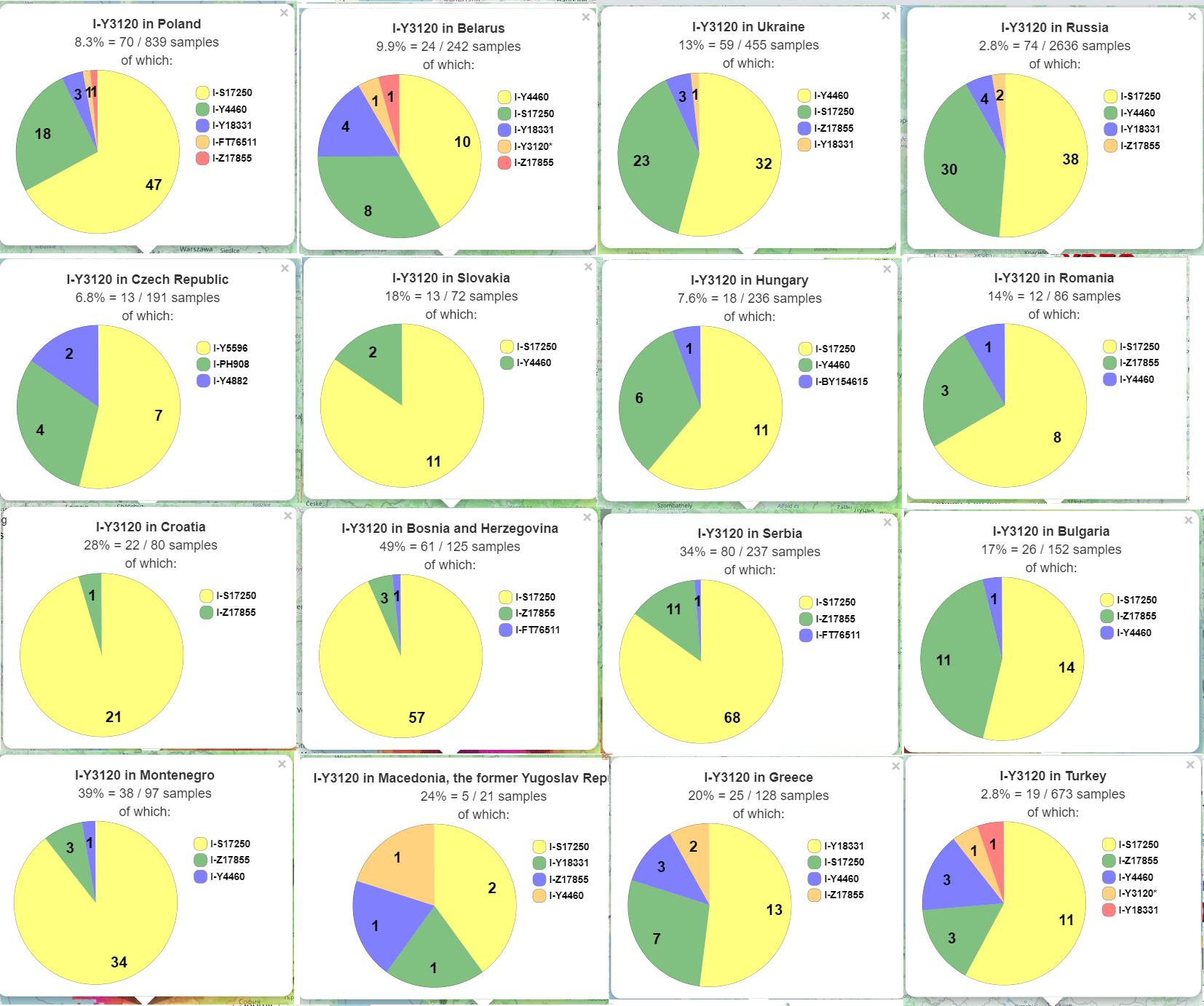
Some countries are disproportionately represented by the most prolific child of I2-Y3120, I2-S17250.
Bosnia, Serbia, Montenegro and Croatia have the least diversity in this sense, and therefore likely do not represent the geographic origin of the I2-Y3120 Most Recent Common Ancestor.
Ukraine and Russia also exhibit low I2-Y3120 diversity, especially considering that the only samples from these countries that are not either I2-S17250 or Carpathian I2-Y4460 (see below) are in I2-Y18331 and I2-Z17855, subclades with very consistent diversity well south of the Carpathians.
The amount of the modern diversity of Poland and Belarus in I2-Y18331 that could reflect the ancient origin is a bit reduced by the fact that 4/4 of the Belarus samples and 2/3 of the Poland samples are below I2-Y23115, which someone anecdotally told me is a Jewish line, and if this is true, might reflect a more recent migration from the more likely ancient origin of Greece. I have not had any contact with any men in this line. I note that there are no Yiddish or Hebrew language codes on any of these 11 samples on the YFull YTree. If you, the reader, manage any of these samples, please consider applying a language code in the event that the sample has an oral tradition of having spoken a different language.
Czechia is least diverse because all the samples are found downstream of just one child, I2-S17250. Slovakia is also not diverse.
Poland and Belarus have a bit higher computed diversity compared to their neighbors Ukraine, Russia, Czechia and Slovakia because one sample in I2-FT76511 is from Poland and one sample at the I2-Y3120 level is from Belarus. Note that the code I have written that computes pie charts does not take into account that this sample is not proven to be basal, hovering over the sample you can see he could be positive for a number of subclades for which he has no call. The Diversity Heatmap does however take 'incomplete-basality' into account.
North Macedonia is interesting because for a country with only five samples of I2-Y3120, four major subclades are represented. Greece and Turkey are also relatively more diverse than some of the remaining countries I have not mentioned.
Greece and Turkey have relatively high diversity, however the samples from these countries positive for I2-Y4460 and some lineages of I2-S17250 probably reflect a later migration from the Carpathians, if modern diversity of I2-Y4460 reflects a deeper origin there (below).
I leave it to subject matter experts to make any further conclusions on their own.
NE Carpathian I2-Y4460
This is the second child line of I2-Y3120 with highest diversity in the Carpathians. The other is I2-S17250 (see above in original post).
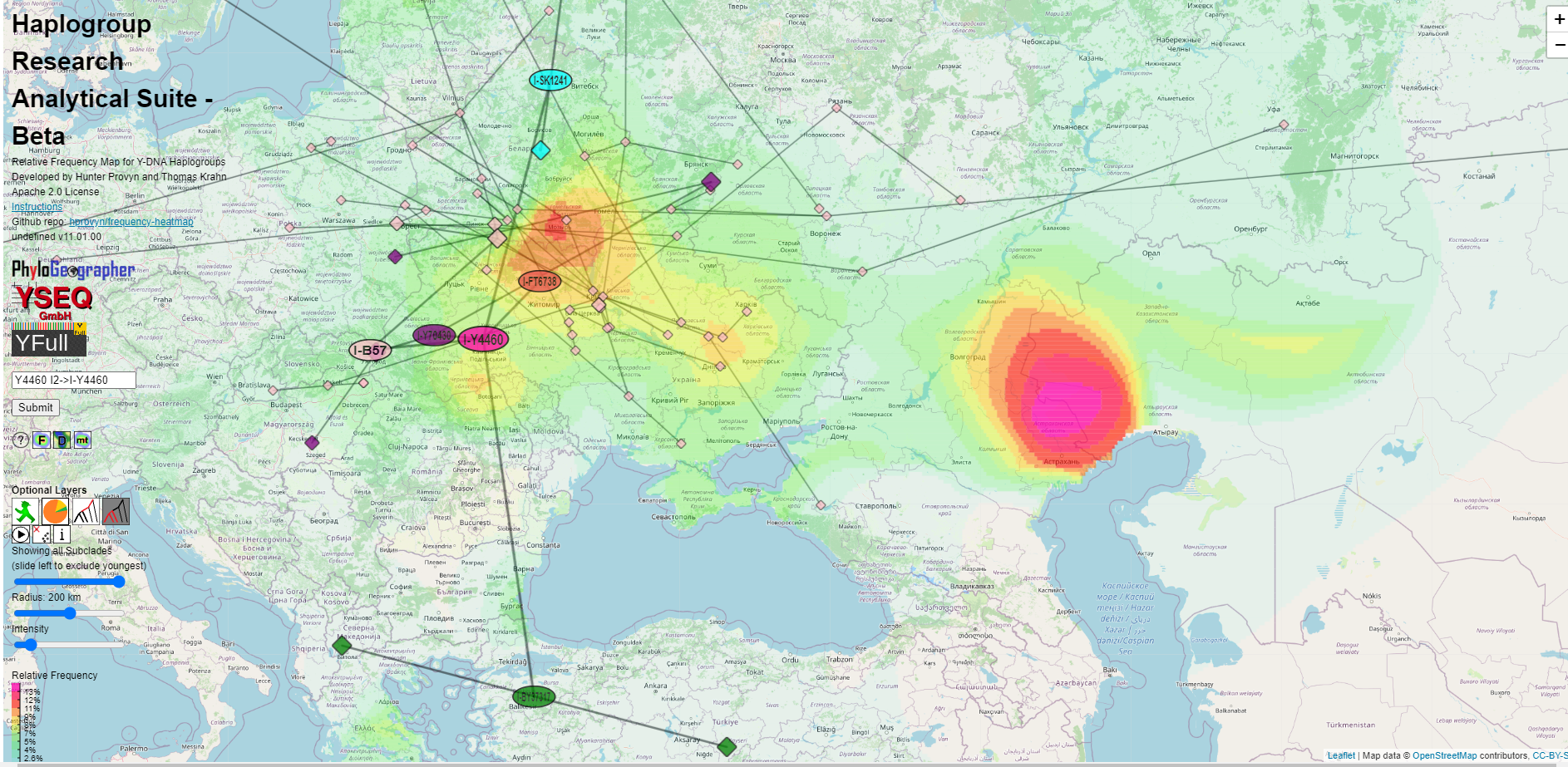
Because it has a more eastern distribution, I did not mark samples from Russia as outliers to be excluded from the computation of the centroids.
Interestingly this lineage did not end up migrating in great numbers to the Balkans where there are now Slavic speakers.
However, one line did migrate to Greece, Montenegro, Syria and Turkey. The YFull TMRCA estimate for this line is 1650 ybp, however the 95% CI is quite large, at 2200-1200 ybp. So this is a bit shaky footing to conclude for sure whether the migration was before or with the Slavs.
I find it noteworthy, however, that the newest sample from Greece, YF115696, ends up splitting the subclade and establishing greater diversity in Greece vs Montenegro for this lineage - I2-FTD23572. These samples don't have accompanying language codes that in many cases make it obvious that that the ancestors were Slavic speakers that we see in many of the other branches of I2-Y3120 that are widespread in the Balkans.
Given that the sole sample from Syria in all of I2-Y3120 is most closely related to these Greece and Turkey samples, I would consider a late Roman Empire migration of Greeks (whose ancestor had Hellenized prior to the TMRCA) as a possible vector by which it became established in Turkey and Syria.
Because the currently computed TMRCA is 1650 ybp, I am open to the possibility that this lineage I2-Y4460>BY37317 may have originally migrated to Greece from the north before the migration of the Slavs, though Slavic migration is also possible if the true TMRCA is later or we are dealing with a co-migration where all descendants migrated together to Greece.
Another factor that I consider makes a pre-Slavic-mediated migration plausible for I2-Y4460>BY37317 is that I2-Y4460 isn't found in any other neighboring Slavic speakers of the Balkans, except for a sole Bulgarian sample.
Another type of migration that could move a Slav to Greece from a population of Slavs that didn't invade the Balkans is through being enslaved by Greek colonies of the Black Sea.
Maybe this explanation is the most parsimonious way to bridge the geographic gulf between Ukraine and Greece. However how likely were offspring of an enslaved Slav in Greece to successful diversify over the subsequent several generations?
So this is the second line in Greece of I2-Y3320 whose diversity in Greece, based on current age estimates, appears to predate documented Slavic migrations - though it could have still been a proto-Slav who migrated in this case (and maybe in the case of I2-Y18331, I didn't think of this possibility when I wrote the original post).
South of Carpathians I2-Z17855
This line's centroid is computed between Bulgaria and Romania, taking all samples into account.
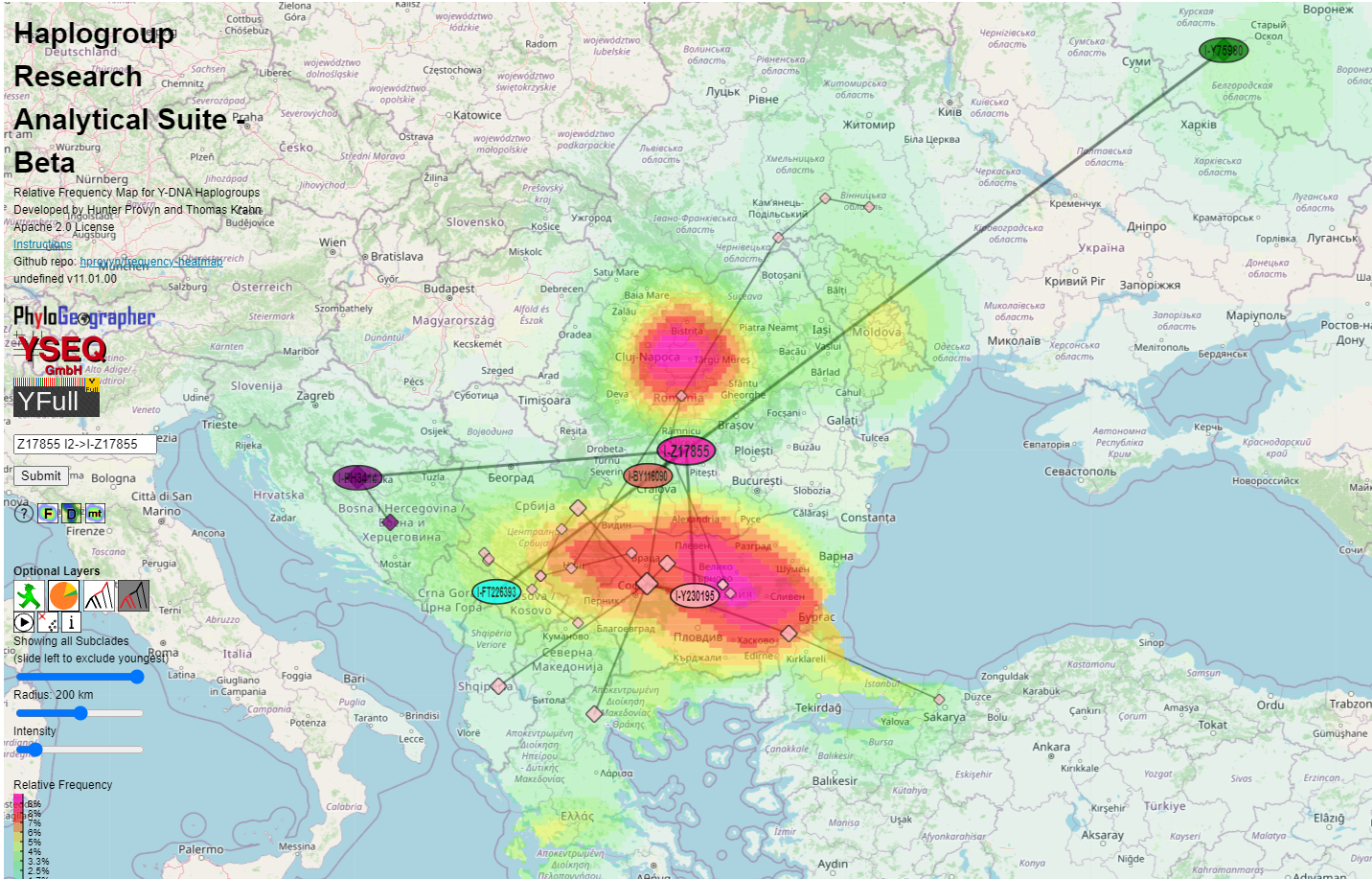
However, setting a country exclusion on Russia, which is an outlier, the computed origin shifts southwest to the tri-state border of Serbia, Romania and Bulgaria.
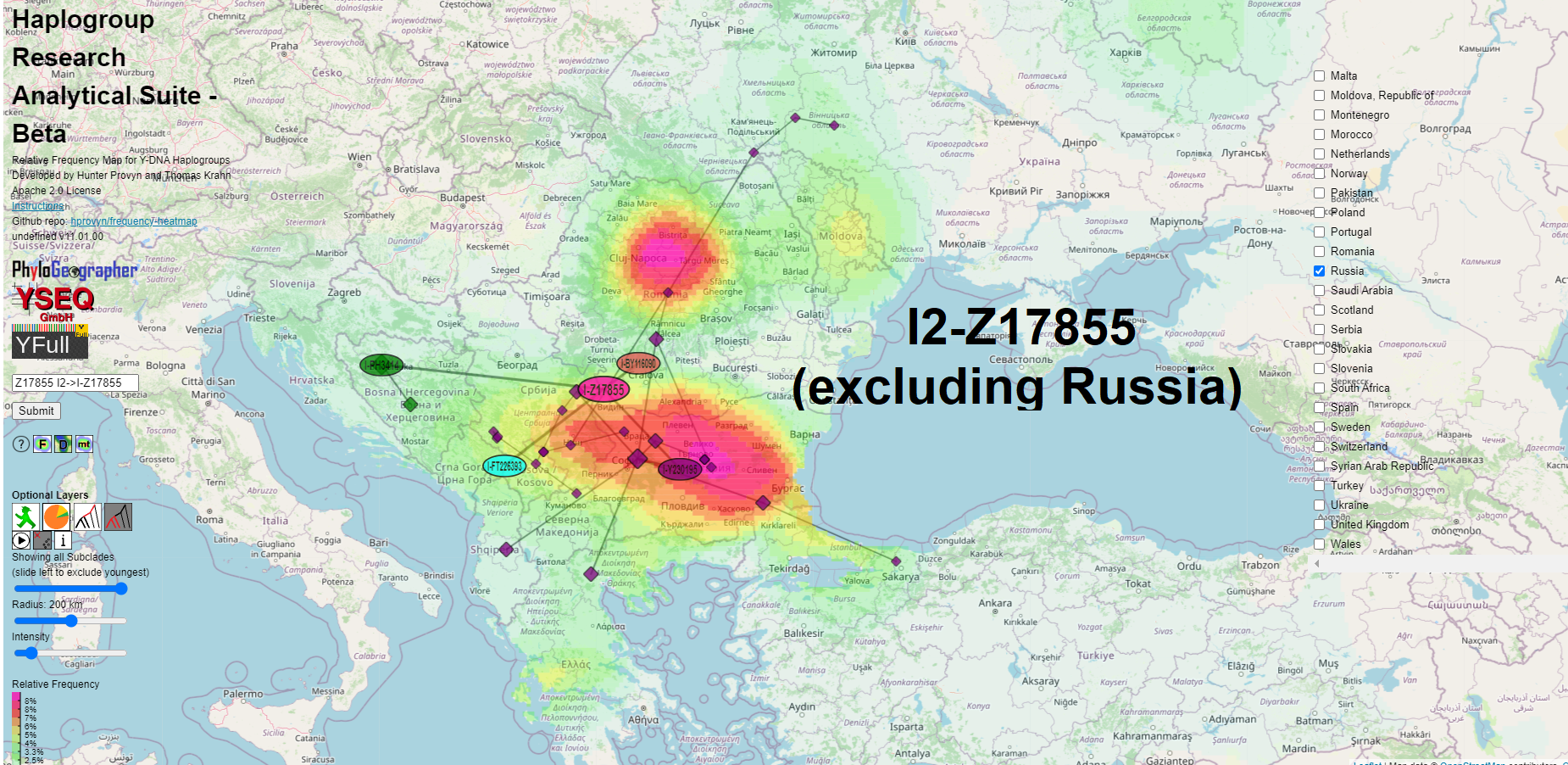
The oldest and most prolific subclade of I2-Z17855 is I2-Y230195, with TMRCA about 1700 years ago.
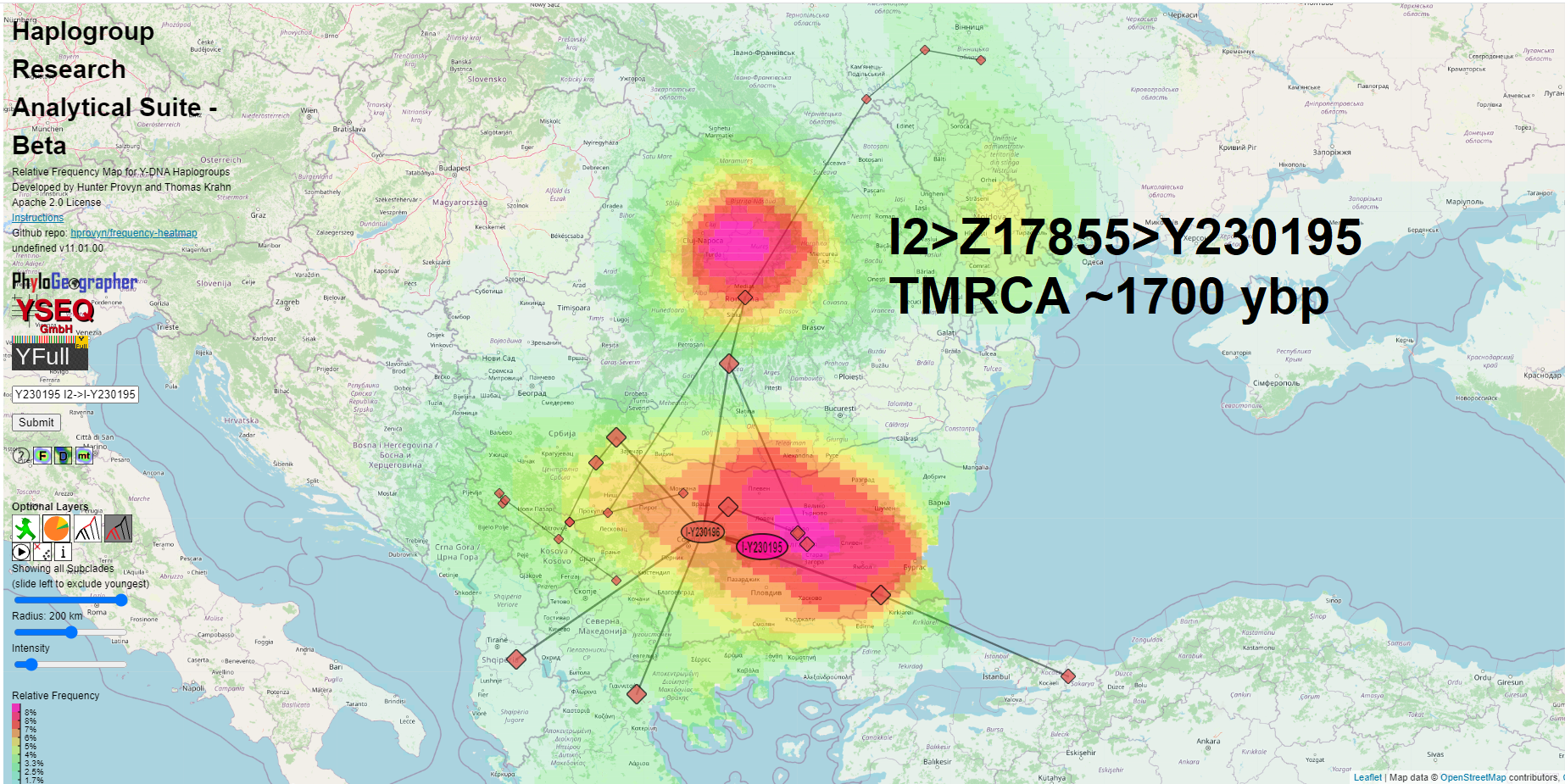
Because I2>Z17855>Y230195's TMRCA is older than its siblings, it contributes more weight toward western Bulgaria for the centroid of parent I2-Z17855.
So I think the TMRCA of I2-Z17855 was most likely living in western Bulgaria or the southern Carpathians.
Given that the 95% Confidence Interval for the TMRCA of I2-Z17855 is 2000-1550 ybp, I think we should be open to the possibility that this lineage, as some of the others of I2-Y3120, may have predated a Slavic migration to the region.
Final Thoughts
We will require ancient samples to be found in clear archaeological contexts to know for certain which of these lineages at which times may have been Celts, Dacians, Thracians, Greeks, Slavs or other groups.
While two lineages of I2-Y3120 have greater diversity in the NE Carpathians, other lineages appear to have originated south of the Carpathians and would likely represent populations, portions of which, in some cases, later underwent Hellenization, Romanization or Slavicization.
Sample ID I18719 has not been radiocarbodated as can be seen from the supplemental data of the Patterson/Reich study of 2021. It was solely archeologically dated. Not only is the mtdna TMRCA an argument for a modern or medieval Slavic individual but also the autosomal DNA which resembles that of modern Slavic populations living in the Balkans. There is an extensive overview of academic evaluations regarding Bezdanjaca mentioning, too, the intrusive presence of even modern human remains from the World War II.
The haplogroup I-Y3120 itself starts to appear in Balkan archaeogenetic records after the Slavic conquest of the Balkan peninsula including Greece. This is evident in dozens of studies from the Balkans or those including samples from the Bakans. The Slavic dispersal connection (both ancient and modern distribution) has been for a long time certain at this point and with it that it is a Proto-Slavic marker and not a pre-Slavic marker of the Balkans.
We have had a recent paper from Greece (Skourtanioti) with more than a hundred samples and again no Slavic marker as I-Y3120 was found, as expected.
I do agree that sample I18719 is probably very recent. There is actually a second sample from the Bezdanjača Cave in Croatia, that also appears to have been mixed-up with the rest of the archaeological finds. I am referring to sample I18721, which is not on YFull’s trees, but, FTDNA has an interesting YTree which includes ancient and medieval samples, https://discover.familytreedna.com/y-dna/I-M423/tree, and we can see that I18721 is actually placed under I-BY128 (better known as I-Y5596) with a TMRCA of 2000 ybp, and if we further judge it by an autosomal heatmap by ph2ter (anthrogenica.com), https://i.imgur.com/EZJeT8S.png, we see that he resembles modern-day Slavic populations from the region.
Having said all that, i disagree with the rest of what you say. Αbsence of I-Y3120 from the archaeogenetic record, in the context of the Balkans, doesn’t mean it wasn’t there by at least, the late 1st millennium BCE. Furthermore, we do have a number of Iron Age I-L621 samples from Serbia and Bulgaria, and even a Middle Bronze Age I-CTS4002 sample from Romania. Regardless of all that, i believe that the Celtic origin of I-Y3120 makes the most sense.
You cannot explain I-Y18331 by the dispersion of the Slavs in the Early Middle Ages. The variance of I-Y18331 is way too high in Greece and cannot be disregarded. Furthermore, Slavic variance and frequency under it is insignificant. Last, Skourtanioti et al.’s (2023) paper doesn’t negate a Celtic or non-Slavic origin for I-Y3120; especially in the context of Greece. The new samples it presented are actually from the Neolithic (n=6), Bronze Age (n=95), and only one from the Early Iron Age (991–835 BCE). The Celtic settlement of southeastern Europe began in the 4th century BCE, and in 280 BCE we have their first descent to Greece; though, i should emphasize, that this was not the only movement of Celtic people towards Greek lands.
Once again, and typical for a Balkan man (Serbian to be precise), the main argument in the discussion is personal opinion.
Regarding the archaeogenetic record, at least by what is on the YFull YTree, there are only two samples from the interval 2500-1200 ybp from Serbia, zero from Montenegro, Kosovo, Bulgaria and Romania.
So I’m not sure if there are enough other ancient samples of the region out there yet to conclusively show that we won’t expect to find I2-Y3120 in pre-Slavic Balkans. As the ancient sampling rate of the pre-Slavic Balkans increases and no I2-Y3120 is found, then it becomes less and less likely that it was there before the Slavs.
I checked that Skourtanioti paper you mentioned regarding over 100 samples. This paper says they analyzed 110 samples from the Near East between the Neolithic and the Bronze Age. So given that I2-Y3120 has a late Iron Age TMRCA, we wouldn’t expect it so show up earlier than that, except if we are lucky and sample exactly where the ancestor of the bottleneck had been living at the time.
The sample is not radiocarbondated, this can be seen in the supplemental data of the paper in question. This is not a matter that is to be discussed as it is a fact. It has Slavic uniparentals and Slavic autosomal DNA. The Skourtanioti paper I am talking about entails samples from the Aegean, where we also got 4 MBA J2b-L283 Z615 samples, analyzed by Flor. As for the lack of samples regarding 2500-1200 ybp, that is incorrect.
I am not going to comment on your methodology and the pre-Slavic association you are trying to make for one of the major two Proto-Slavic haplogroups (my standpoint is obvious in this regard) but using solely Yfull in any sort of argumentation won’t get you nowhere.
It is 2023, we have hundreds and hundreds of samples from the Balkans (inlcuding Serbia) and Greece and none of them yield the Slavic haplogroup I-Y3210, you are arguing for a lost cause here. The early medieval Slavic conquest has replaced major lineages of the pre-Slavic Balkans including J2b-L283 hence it is ironic having a J2b-L283 researcher propagate a Balkan-Slavic autochthonous theory (devoid of fact) for a Slavic haplogroup that has been fundamental in this replacement process.
PS: there are papers with aDNA data from Serbia on the way and none will yield Slavic unparentals, again, no surprise in 2023.
What does the paper from Skourtanioti, which studies the prehistoric and early historic Aegean world, have to do with what the blogger here discusses? Why would anyone expect a haplogroup that at the absolute earliest estimate enters Greece around 200BC (and the blogger works under this assumption) to appear in the sampling of a paper that covers the Neolithic and Bronze Age? We known where Y3210 comes from and it is not the Balkans. The whole discussion here is how exactly its different subclades managed to spread around and under which conditions. Where exactly is the evidence from dozens of papers that explain with detail eg how Y18311 arrived in Greece when Greece itself is woefully understudied in the aDNA department, especially in the Hellenistic and Roman imperial timeframe which interests us here?
By replacing slavic “conquest” with “displacement” will be find the clarity. The I2 parent is recorded arheologicly in gothland island. There are many records (Greek writings) of those times (3-5 centuries) when the germanics (goths, gepids, geats) from Scotland brought and bought slav women (and castrated slav men) to constantinopol. In the same time, they (the germanics) ruled all the territory of north side of Danube- black sea. So, there was a massive, exponential reproduction of Germanic genes, one men subjugating a big number of slav women. Because the culture/language is given by mothers, the descendants of those Germanic y-DNA rised in a slavic mtdna culture were culturally slavs.
Because of hunic pressure in 5th cen. a half of those slavic germans entered the Balkans. There are the Greek records of goths negotiations to settle the Balkans and masakring the local population. So, the Germanic slavs appeared in Balkan by an unexplained fenomen, suprising the Greeks, because there was not recorded somehow conquest/invasion. There was a concreat gothic settlement but become a slavic culturally.
Their women the goths left on the border of Baltic sea, and they gave the Germanic side to pols, lithuanians. Seems there were a one direction travels for the adventurous Germanic men (maybe they hadn’t the best geographical knowledge, and there was easy to flow in the direction of the river but not against the flowing direction for returning).
Bezdanjaca cave’s I-Y3120 samples I187119, I18721 (and I18723 whose R1b) have been extensively discussed at Anthrogenica and other specialized forums or authors. They are misdated and completely unreliable for such theorization. They are medieval or modern samples. Raw files have serious issues (per authors of NEVGEN calculator), and autosomally look like modern South Slavs which is impossible for the supposed Bronze Age. They do not match Croatian or Balkan Bronze Age samples. They are nothing alike same period (Proto-)Illyrian, Thracian etc. samples from the region even almost 40 other samples from the same cave or those in Iron and Antiquity Age. As said, one Bezdanjaca cave sample has mtDNA haplogroup which is present only in Central-Northeastern Europe (HV0a1 > HV0a1a1b with very recent TMRCA), which is not a coincidence. Also, Bezdanjaca cave I-Y3120 samples are dated 1000 and more years earlier than I-Y3120’s TMRCA itself and the second Bezdanjaca cave sample I18721 has one read at Y3120>S17250>Y5596 level: Y5596/BY128+ A>C (1C) (formed 2000 ybp, TMRCA 2000 ybp), making it seriously misdated. Poor raw file quality is hiding derivative mutations and not helping especially the case for Balkan autochthonous “continuity theory”. Another most important issue with Bezdanjaca cave is that those bones were excavated since the 1970s without modern methods, there was almost no carbon dating, at least for I-Y3120 samples, and the same cave has bones & archaeological artefacts from the Bronze Age to the Modern Age. It is one of several cases when archaeological research corrected archaeological misdating of bones.
Among hundreds of prehistoric and ancient DNA samples from the Balkans until now those which are I-L621+ > I-CTS10228+ > I-Y3120+ is roughly 1% which shows, if rightly dated (which is improbable), that the line was very rare, not typical for the Balkans until medieval times, the supposed 1% I-L621+ population could not have reproduce in such an enormous numbers in the end of antiquity nor the subclades were found in Roman samples from Dalmatia or Hunnic, Germanic etc. first phase migration period samples from Pannonia and elsewhere, and the I-Y3120+ samples found in Hungarian Conqueror elite have often Asian autosomal traces and Asian mtDNA lineages showing they weren’t typical of local Pannonian-Balkans population. There’s also no evidence for major South-North migration which could explain such widespread frequency and diversity among Eastern and Western Slavs.
98-99% of I2a among modern South Slavs are not I-L621+ or I-CTS10228+ but only I-Y3120+ subclades out of which very young I-PH908+ (formed 2000 ybp, TMRCA 1700 ybp) subclades make on average 50-70% alone; I-PH908+ represents so-called “Balkan” haplotype cluster which is derivative of “Dnieper-Carpathian” cluster; higher modern diversity of the subclade, sister subclades and ancestral clades are in Eastern Europe not Southeastern Europe proving the latter was never ancestral homeland; frequency and diversity of I-L621 among South Slavs is so high and so low that it cannot be any kind of continuity of the I-L621, I-CTS10228 or I-Y3120 line in the Balkans since Bronze Age, Iron Age or Antiquity only founder effects since medieval times. More and more samples are being added to the FTDNA and YFull haplogroup trees which show that Balkan samples have distant cousins in Eastern and Western Europe, cousins dating to the premigratory and/or migratory period of the early Slavs.
Contemporary distribution of I-M423 clades and subclades I-FGC41353 > I-Y3104 > I-L621 > I-CTS10936 > I-S19848 > I-CTS4002 up till I-CTS10228 is in Western and Central Europe, not Southern nor Eastern Europe. The clade I-Y3120 became widespread in Eastern Europe most probably via eastward Proto-Celtic migration from Central Europe, having a central role in Proto-Slavic ethnogenesis. From there it spread to the Balkans in the early medieval times.
These are facts. There is no valid argument and evidence for the continuity of the I-L621 line in the Balkans until medieval and modern times. The continuity theory by now is a fringe theory with extraordinary claims which require extraordinary evidence. After so many ancient DNA samples the evidence is extraordinarily lacking and there’s nothing in sight to indicate otherwise.
I appreciate the detailed responses regarding the ancient sample I18719 that I referred to in my article as being controversially dated as 3200 ybp on the YFull YTree.
Regarding this ancient sample, I think the best thing I can do is to recommend you and others to, as concisely as possible, present your arguments to the YFull YTeam.
They may then decide, in light of the evidence, to remove the ybp for this sample on their tree (or remove it altogether).
I appreciate the argument that an autosomal result can in some cases prove that that a sample cannot be older, if autosomal results of ancient samples yet found do not exhibit a particular kind of mixing that we only see in more modern samples. I’m not a subject matter expert on autosomal DNA comparison to reference populations let alone Balkan autosomal DNA so I cannot give an opinion on this ancient sample’s autosomal DNA.
To challenge your main point, that a non-Slavic tribe mediated migration is out of the question, I’ll just mention something additional regarding I2-PH908 which you bring up. This may be the key to understanding this whole lineage.
If we take I2-PH908’s TMRCA, the 95% confidence interval is 1550-1850 ybp. This predates the migration of Slavs to Europe, but on its face doesn’t mean the ancestor wasn’t a Slav in the Carpathians. However, Diversity Heatmap computes the greatest diversity of this line between Serbia, North Macedonia, Kosovo and western Bulgaria, by a landslide. So, without ancient samples proving the ancient origin one way or the other, I think we should be open to the possibility that this line Slavicized in situ, given the YFull TMRCA CI and the computed diversity.
I’m interested to see your alternative method of calculating diversity that shows this lineage is more diverse elsewhere than Serbia, North Macedonia, Kosovo, western Bulgaria.
https://phylogeographer.com/scripts/diversitymap.php?newlookup=I-PH908
If you hit minus a few times on the intensity, you will see the peak around the countries I mentioned.
In my opinion, the Dacians are just one major people who inhabited this approximate region and were known to be dominant around the time of the TMRCA. They were exacting tributes from the Romans – not many tribes were organized well-enough to do this. A Celtic group such as the Scordisci, just one example, are another possibility of a dominant group in the pre-Slavic Balkans, and like you said and which I agree with, this line could have ultimately deeper Celtic origins from further NW.
I think you are again missing several key points in the argumentation. There was no medieval migration of I-PH908 as such, what migrated it is its even younger subclades which were already spread among different Early Slavic tribes & Early Slavic archaeological cultures. YFull YTree’s primary function is not to show real diversity in the population & location. The diversity heatmap is misleading and pointless to use to make any detailed conclusions (at least for such young subclade as I-PH908). The high number of Serbian etc. samples of different subclades is due to the public and private endeavors of Serbian DNA Project and lack of it in other countries. In other countries it is mostly private people’s interest and financial capabilites. It is a classic example of sample bias. You don’t get such diversity in scientific papers & samples (it’s highest in Croatia-BiH-Serbia), also Serbia actually has the highest number of duplicate haplotypes and less diversity per sampled population size than Bosnia and Herzegovina or Croatia or others, meanwhile, some other Eastern Balkan countries could also have high diversity, but have lower frequency than Western Balkan countries. Whatever the case, the individual subclades diversity was not studied enough (SNP), besides for Serbia/Serbs and maybe Montenegro, to claim with certainty where is the peak diversity in Southeastern Europe (realistically, it is most probably almost equally widespread all over the region, or could be highest in Serbia because it is naturally & historically between Western and Eastern Balkans population migratons), even if your assessment is true, it is mostly showing that the main movement of the people with I-PH908 was related to the Scalveni & Antes tribes who migrated from & along Eastern Carpathians – nothing else – and that’s arguably the “mainstream” theorization. TMRCA of I-Y3120 etc. subclades correspond to the early Slavic cultural and anthropological emergence on the historical scene & migration period. The frequency and diversity among all Slavic nations is hard solid proof it was not the result of pre-Slavic Balkan population. Currently there’s no valid evidence and no valid argument – including in your article – we can & need to be open to the possibility that this line Slavicized in situ, that’s the main issue. There’s no reliable and valid evidence or argument. All or almost all put forward are incorrect and such incorrectness, usually unknown to the person, gives spaces for even more incorrect assumtpions. I agree, both YFull (and FTDNA) should or remove these samples or remove their dating & archaeological context because it is very misleading for the public.
I’ve added an addendum today showing a few other south of Carpathian lineages along with diversity charts for each country. I think in some cases, lineages of I2-Y3120 may have Slavicized in the Carpathians before migrating onward, but in other cases, the lineages appear to have already been living south of the Carpathians since before the 5th century.
If I2-PH908 subclades all later, coincidentally only migrated to the Serbia/Bosnia border region (if once eventually verified by ancient DNA), then this is definitely very useful information about the propensity to stick together, i.e. co-migrate hundreds of years after the MRCA lived, to take into account going forward looking at other subclades. It will be interesting when we finally have ancient DNA.
“I think in some cases, lineages of I2-Y3120 may have Slavicized in the Carpathians before migrating onward, but in other cases, the lineages appear to have already been living south of the Carpathians since before the 5th century” – it does not, again projection of incorrect interpretation of very exact genetic & historical data. I don’t know how many times it needs to be repeated, YFull YTree primary function is not showing diversity by location, and samples there are classic example of sample bias. In case of South Slavs obviously it is showing diversity due to Early Slavs migration to the Balkans where it is their “genetic-dead end” on the migratory road. TMRCA correspond to the Proto Slavic & Early Slavic era – nothing else – everyone, even the neutral experts, are already annoyed with the so-called “anti-Slavic” theories. Slavs mainly repopulated Southeastern Europe almost 1500 years ago – the end. The ignorance of Russian samples is also wrong, almost half of I-Y3120+ population members are living in modern day Ukraine-Russia, we don’t have their population proportion in YFull YTree due to general and private sample bias (including due to financial capabilities, interests, and current war will be only for the worst). By now we have, repeat, hundreds of ancient DNA including from pre-Roman, Roman and the Hunnic-Gothic era and there is no, and those which are there is no reliable I-Y3120+ pre-Slavic sample, and hence “some lineages of I-Y3120” is a conclusion without any valid foundation, only a superficial misinterpretation of the data.
I think I-Y3120 being a Dacian marker originally is far fetched.
The great diversity that exists in Bosnia and Herzegovina distorts the real picture about the longitude and latitude for this haplogroup.
It’s obvious that the tribes that migrated in Bosnia and Herzegovina during the early Medieval had quite the diversity of I-Y3120 and as such it’s very likely that in their ranks that single progenitor known as I-Y3120 was born and raised.
And these tribes were Slavs.
Some of them were known as Serbs.
The initial point of migration of these tribes towards the Balkans is a point of interest and its very likely the initial point of dispersion of I-Y3120.
And I think your second center of diversity that exists in southern Poland and Slovakia is where the Serbs and other western South Slavs came from and this is the initial place of dispersion of I-Y3120.
Now the questions in relevance to I-Y3120 are :
What was in the Polish and Slovakian Carpathians during the period between 500 BCE – 0?
Were these Serbs and other Slavs in the Polish and Slovakian Carpathians during that period or they came from somewhere else later on?
And did I-Y3120 came with them if they have migrated there from somewhere else or was it assimilated in the Polish and Slovakian Carpathians?
Also just a small remark.
Probably you aren’t very familiar with Balkan history but those samples that have mkd and bul as mother languages aren’t recent arrivals in northern Greece the same way we can describe those with pnt Pontic Greek language.
Northern Greece was very Slavicized and ever since the early Medieval was a region divided among the Slavs and the Greeks.
Today, even though heavily reduced, the Slavic minority still exists.
This is interesting and I agree that i-y3120 was likely dacian or Celtic and was assimilated by r1a Slavs. What do you make of my ydna (i-y230195) and what would be the history behind it? I am from Albania by the way, I will upload my result to yfull one day – https://www.yfull.com/tree/I-Y230195/
I do agree that sample I18719 is probably very recent. As mentioned above, there is also a second sample from the Bezdanjača Cave in Croatia, that also appears to have been mixed-up with the rest of the archaeological finds. I am referring to sample I18721, which is not on YFull’s trees, but, FTDNA has an interesting YTree which includes ancient and medieval samples, https://discover.familytreedna.com/y-dna/I-M423/tree, and we can see that I18721 is actually placed under I-BY128 (better known as I-Y5596) with a TMRCA of 2000 ybp, and if we further judge it by an autosomal heatmap by ph2ter (anthrogenica.com), we see that he resembles modern-day Slavic populations from the region.
Having said all that, absence of I-Y3120 from the archaeogenetic record, in the context of the Balkans, doesn’t mean it wasn’t there by at least, the late 1st millennium BCE. Furthermore, we do have a number of Iron Age I-L621 samples from Serbia and Bulgaria, and even a Middle Bronze Age I-CTS4002 sample from Romania. Regardless of all that, i believe that the Celtic origin of I-Y3120 makes the most sense. Therefore, in my opinion, in order to better understand the clade, we should be focusing on the history of the Balkan Celts; such as the Scordisci and the more debatable Bastarnae, among others.
Furthermore, we cannot explain I-Y18331 by the dispersion of the Slavs in the Early Middle Ages. The variance of I-Y18331 is way too high in Greece and cannot be disregarded, while Slavic variance and frequency under it is insignificant. Last, Skourtanioti et al.’s (2023) paper doesn’t negate a Celtic or non-Slavic origin for I-Y3120; especially in the context of Greece. The new samples it presented are actually from the Neolithic (n=6), Bronze Age (n=95), and only one from the Early Iron Age (991–835 BCE). The Celtic settlement of southeastern Europe began in the 4th century BCE, and in 280 BCE we have their first descent to Greece; though, i should emphasize, that this was not the only movement of Celtic people towards Greek lands.
I would like to bring to the attention for all of you, that a seminal work which tries to prove Slavic origin, is nothing but the student PhD thesis at the Kharkov University of Ms Utevska which uses samples collected in the Bukovina, settled by either Romanians, Ukrainians and Ukrainized Romanians and than including them in analys. From this misunderstanding of the geographical location of the samples collected, conclusion was brougt by others on the equal spread in the purely Slavic regions of Ukraine.
She even specificly says that “The Bukovina population differs from the typical Ukrainian population by higher frequency of I2a (Р37.2) and lower frequency of R1a1a1*(М198).”
This is a resume of her paper translated into Emglish.
“The territory of present-day Ukraine is subdivided into some regions with specific demographic and politic history. Nevertheless, the corresponding subdivision in genetic structure is not revealed in previous investigations: populations of Ukrainians under study were genetically homogeneous on SNP markers of Y chromosome. In the current investigation we studied the Y-chromosomal genetic structure of Transcarpathia and Bukovina populations. Several factors exist to expect the genetic specificity of these populations. Both ones are placed in the Carpathian foothills, at the south-western border of the Ukrainian area. During the last millennium these territories were the parts of different states and were open for ethnically diverse migrations. It was revealed that the major Y chromosomal haplogroups in Transcarpathia population were R1a1a1*(М198), I2a (Р37.2), R1a1a1g (М458), E1b1b1a1 (M78). The major haplogroups in Bukovina population were I2a (Р37.2), R1a1a1*(М198), R1a1a1g (М458), R1b1b2 (М269), E1b1b1a1 (M78), I1 (М253). The Bukovina population differs from the typical Ukrainian population by higher frequency of I2a (Р37.2) and lower frequency of R1a1a1*(М198). Moreover, this is the only population among ones studied in Ukraine where the most frequent haplogroup is I2a (Р37.2) but not R1a1a1*(М198). Such a deviation can be caused by possible mixing with neighbouring southern groups, and Carpathian mountains were not a border for exchange in this case. Interestingly, the haplogroup N1c (M178) is not revealed in Transcarpathia at all, obviously due to the mountain barrier. It was revealed by principal component analysis that Ukrainians from Transcarpathia and Bukovina despite some specific peculiarities are more similar to other Ukrainian populations than to the surrounding ethnic groups such as Poles, Slovaks, Hungarians, Romanians, Moldavians and Gagauzes. Ukrainians of Transcarpathia and Bukovina form the entire genetic continuum with the whole Ukraine on maps of gene distances, confirming the homogeneity of Ukrainian parental gene pool and it’s differentiation from other groups. After performing the analysis of Y-haplogroup spatial distribution, it is supposed that the northern ridges ofCarpathian mountainsare the East-European barrier decreasing the gene flow. It decreases the spreading of haplogroups N1c (М178) and R1a (М198) southward and movement of E1b (М78), R1b (М269), J (М304) and G (М201) northward.”
https://www.researchgate.net/publication/283860037_Populacii_Zakarpata_i_Bukoviny_na_geneticeskom_fone_okruzausih_terrially.
On history of the region:
https://historia.ro/sectiune/general/bucovina-dulce-bucovina-cum-a-ajuns-sa-fie-rupt-571136.html
On demographical histiry https://www.ceeol.com/search/article-detail%3Fid%3D467982
https://www.researchgate.net/publication/44797052_Bukovina_and_the_evolution_of_its_Northern_FrontierBoundary_Migration_Demographic_Pressures_and_Regional_versus_Linguistic_versus_National_Identity
https://depot.ceon.pl/bitstream/handle/123456789/5460/The_demography_of_Romanians_in_Bessarabia_and_northern_Bukovina.pdf%3Fsequence%3D1
In short region was occupied by Austrians in 1775 from the Principality of Moldavia
The census at that time didn’ register ethnicity, only religion and both Romanians and Ukrainians are Orthodox. First available cesnsus is the Austrian census of 1850–1851, which for the first time recorded data regarding languages spoken, shows 48.50% Romanians and 38.07% Ukrainians. In 1918, it ceeded from Austro-Hungaria and united with Romania, but in 1940 based on the Hitler-Staĺlin Pact, the USSR occupied northern part which is now part of Ukraine
You can delete the article, the debate and discussion is over.
“ancIBD – Screening for identity by descent segments in human ancient DNA” (2023, H. Ringbauer, Y. Huang, A. Akbari, S. Mallick, N. Patterson, David Reich; https://www.biorxiv.org/content/10.1101/2023.03.08.531671v1.full).
I18719 has IBD matches with SZA-29.SG (1000 CE, Hungary), I0736 (6300 BCE, Turkey), I20225 (565 BCE, Turkey), PLE-195.SG (975 CE, Hungary), I13833 (1625 CE, Albania), VK313_noUDG.SG (875 CE, Denmark), R10654.SG (303 CE, Austria).
I18721 has IBD matches with I15462 (sum_IBD>12) and I15742 (750 CE, Croatia), MH-153.SG (1050 CE, Hungary), R3482.SG (1100 CE, Montenegro), R9919.SG (970 CE, Montenegro), ALM036 (1900 BCE, Spain), VK312_noUDG.SG (875 CE, Denmark), I6581 (2300 BCE, Poland), I2618 (2050 BCE, England), I1843 (2950 BCE, Spain), hem004.SG (3175 BCE, Sweden).
In other words, I18719 and I18721 are proven to be from at least Middle Ages and not to be from the Bronze Age or some other pre-medieval or pre-Slavic period. They mainly have matches with samples in medieval period. Their archaeological dating is genetically confirmed to be wrong. I-CTS10228>I-Y3120, which are not found in any other Southeastern European ancient DNA samples neither these two samples have IBD matches with Southeastern European pre-medieval ancient DNA samples, are proven to be 100% related to the migration of the Early Slavs or Slavic ancestry.
FTDNA Discover Haplotree has for a reason written disclaimer: “Phylogenetic Y-DNA analysis by FamilyTreeDNA. Ancient DNA samples are typically degraded and missing coverage, sometimes resulting in less specific haplogroup placements. * In some cases, the Time to Most Recent Common Ancestor (TMRCA) estimate is younger than the ancient sample’s age either because of lack of Y-chromosome coverage where the sample could otherwise split the branch or because of incorrect sample dating based on radiocarbon or archaeological context.”
Regarding Greece, while it seems clear that the Y18331 arrival predates the Slavic migration by some centuries, , Y4460 is a good candidate as a marker for the first, early Slavic settlers there. Z17855 seems to have a different story and may be related to the Bulgarian element in Greece both in terms of medieval contacts (war between eastern Roman Empire and the medieval kingdom of Bulgaria) and Greek nationals of Slav Macedonian origin (plenty of Bulgarian speakers identified as Greeks during Balkan wars and there are bilingual populations to this day). I also suspect Z17855 is linked to Vlachs. My own Greek matches that carry this clade, all appear to have surnames typical of Greek vlachs or the surname Vlahos itself (self explanatory). This might indicate that some Slavicized Z17855 carriers were incorporated into Aromanian/Vlach populations during their migration to the Balkans
“By the way only one sample from Italy on YFull could possibly descend from a Dacian slave sent to Rome at that time, in this branch I2-FT277965.”
Or he was simply Slavic cavalry men recruited by Belisarius who were awarded land in Sardinia for exceptional service in Byzantine army. All of which was documented.
There are two samples from the study in Italy, both from Sardinia. They form branch YP206, just under FT277965.
Yes, that is also possible.
https://discover.familytreedna.com/y-dna/I-FT288887/story
My father is mishar tatar from the Republic of Mordovia.
Any thought?
Genetic history of East-Central Europe in the first millennium CE (24 July 2023)
https://doi.org/10.1186/s13059-023-03013-9
A medieval Slavic sample from Poland, PCA0156 (dated 884/1013 AD) is I2-Y18331 so even the discussion about non-Slavic origin only of one Y3120 subclade, Y18331, became rejected as well.
How does a medieval sample from 884–1013 CE Poland, disprove the non-Slavic origin of I-Y18331? We already had a modern Polish sample that appeared on YFull’s Ytree in 2020, which belongs to an unknown basal clade of I-Y18331. However, we also have a Greek sample belonging to an unknown basal clade of I-Y18331, and three additional basal clades of I-Y18331 with many Greek samples under them. The variance of I-Y18331 is way too high in Greece, while Slavic variance and frequency under it is insignificant. The medieval sample from Poland simply suggests that right after I-Y18331 was formed between 200–100 BCE, some members remained in northern/northeastern Europe, while others migrated quickly towards Greece. This doesn’t disprove the non-Slavic origin of I-Y18331 or the broader I-Y3120. Many non-Slavic people inhabited northern/northeastern Europe when the basal clades of I-Y3120 were formed. The variance and frequency of clades above I-Y3120 clearly indicates that it ultimately came from lands further to the west.
As a carrier of I-Y23115, I can say quite confidently that all the modern carriers of that SNP are Eastern Ashkenazi Jewish based on my Big Y matches and their listed ancestors.
I think estimated tmrca is terribly wrong …off for maybe 1000 years….it is not possible to have such diversity and spread in historic period….if you start to look at it as much more distant past everything becomes much more logical…
now armed with this insight look at I2a PH908 diversity
hotspots are Sparta in Greece,, Sofia in Bulgaria named after Celtic tribe Serdi that settled there…lesser hotspots are ex yugoslavia especially Serbia, Syria, central area of Turkey (matching Celtic Galatia settled by Celtic tribes most likely Scordisci), than Carelia in Russia, area, south Sibir area just north of Mongolia and central Ukraine, Syria, south Sardinia, Poland, Chech republic….
if you increase relative diversity to maximum you can also see hotspots in Italy around L’Aquila area (where Sabines who are descendents of Spartans lived), Belgium around Liege (where Caerosi tribe lived) and area south of Stuttgart in Germany where tribe Caritini lived…
Do you now start to see the pattern? those are all names with Sar/Ser /Car/Har related etnonyms….Serbia, Syria, Sparta, Sabines, Carelia, Caroesi, Caritini, Scordisci, Siberia, Croatia (Hrvati in SerboCroatian), Sorbs( in east Germany), Sardinia….
Caerosi tribe is in Wallonia around Liege …. word Wallonia comes from germanic Walha meaning stranger and used mostly for Celts….Caerosi has an unexplained suffix (-oeso-), which is not found in either Celtic or Germanic languages…The name has been discovered on a Roman era boundary marker carved with the inscription ‘FINIS PAGI CARV CVM…so it was written as Carv in latin….
Please investigate this
A genetic history of the Balkans from Roman frontier to Slavic migrations (December 2023)
https://doi.org/10.1016/j.cell.2023.10.018
-In our dataset, I2a-L621 and R1a-Z282 only appear after 700 CE (Figure 5 below; Data S2, Table 1), always associated with Eastern European related ancestry in the autosomal genome, which supports that these lineages were introduced in the Balkans by Eastern European migrants during the Early Medieval period. Lineage R1a-Z282 shows highest frequencies in Slavic-speaking groups from Central and Eastern Europe [160]. Lineage I2a-L621 reaches highest frequencies in present-day populations from Bosnia-Herzegovina, Croatia and Serbia [161], and it is also present in other Slavic-speaking groups such as Russians or Ukrainians
Accurate detection of identity-by-descent segments in human ancient DNA (December 2023)
I18721 again is a IBD match with I15462 (750 CE, Croatia)
—
This article is a prime example how uncritical understanding of population genetics, Slavic and Dacian history, and usage methods such as “the prism of geolocated samples on the YFull tree and the estimated TMRCAs” can be awfully misleading to wrong ideas and conclusions. This article is only misinforming and confusing the public. It does not have any other purpore. It must be deleted if there is no clear disclaimer it was a mistake with edited wording by the author.
Thanks for linking the 2023 article. It is behind a paywall for me so I cannot read it.
Are any ancient Dacian samples mentioned in the study?
Are you disagreeing that I-Y3120 could have originated in the Carpathians or that if it did, it could not have been found among Dacians?
I think it’s good to identify the diversification in Greece of I-Y18331 and then whenever it is resolved, wherever I-Y3120 actually originated, it will help us understand what types of migration in general are possible (i.e. a possibly much later co-migration of very distantly related people leaving no trace elsewhere).
The archaeological age estimate of I18721 on YFull and the YFull/FTDNA estimated TMRCAs are outside of my ability to change.
The female line of I18721 does match a later, Slavic geography better, going by YFull samples.
However, it still is a weird coincidence regarding the misdating of I18721 that happens to match the Bronze Age estimate of the I-CTS10228 TMRCA.
The single ancient sample below I-CTS10228 that is given a Bronze Age archaeological estimate is the only one that could actually have lived during the Bronze Age based on not being positive for a line that formed later.
I still find this to be a noteworthy coincidence worth having mentioned.
I’ve added the following caveat to my article:
[EDIT 3/10/2024: The geographic diversity of the female line, per YFull mtree samples, going back several branches, fits best with a general Slavic ancestry rather than indigenous to the Balkans]
I am interested in the programs you are working on in the field of population genetics. However, you should be aware that the results we get from these programs will depend heavily on the accuracy of the data available to you. That’s why it would be good if you give the possibility that some data can be turned off, ignored. There is a lot of information in which the respondent intentionally provided information that is not correct. On the other hand, you completely ignore the data from the myFTDNA database. I don’t know why you do that, maybe there are legal norms that prevent you from using that data? It’s pointless to follow your predictions if it is known that you are ignoring half of the data that is public. In the case of Y-4460, completely ignore 639829, 343565, N126988, 493005, and if very likely they are BY37317 branches. I note that my last name is the same as the name of their city. OK, they are not proven to be branch BY37317, but in the case of IN114043 they are, and the location it was tested for is listed as being close to the location of these four who did not continue testing. This information is public to you and you cannot ignore it because you will get a completely wrong result. But you didn’t stop there! At this link https://docs.google.com/spreadsheets/d/1pHvOMVZPtNDuwVabSXD7OxdFMTYQGvfjq7Z-L6IiII0/edit?fbclid=IwAR0Qv8T9PurGc7fgZ8o8ivFO08HHd9R1kVGEu4x-US2ACnrf0Eg7IoFj0-c&gid=450884960#gid=45088 4960 you have the results of two tests within one of the Turkish projects. Both tested on YFul, Y-4460 >BY37317>FT65490. They are listed as Turks, but it is not stated what language they speak. Read the note at the end of the table I sent you, which refers to these two results. For SRS8752269 it literally says: Turk_Greece @ 4.54668 | Turk_Macedonia @ 4.796895, and for SRS8752122: Turk_Bulgaria_North @ 3.887788 | Turk_Greece @ 4.771572, which tells which population they belong to within the very complex Turkish society. Please note that they come to Turkey from the same area where the tested people I spoke about earlier live, which is the triple border of Greece, Macedonia and Bulgaria. It is a Slavic ethnic group that you can learn more about at the link: https://en.wikipedia.org/wiki/Pomaks.
We also note that d:YF110812 is from Thessaloniki, which is very close to the triple border of Bulgaria-Macedonia-Greece, regardless of the fact that they are not of the same nationality. The authenticity of the data for id:YF115695 should be suspected and the program should be allowed to consider the migration path without it.
I would also like to mention that the tested ID:YF100128 from Syria know that their progenitor is Musa Pasha from the Balkans, specifically from Bosnia. The problem is that two pashas with the name Musa lived at the same time and that their biographies are intertwined and it is often not known which of the two personalities the historical sources refer to. Both served in Hungary, Greece and Egypt, and are believed to have been born in Bosnia. However, much remains unclear and research continues.
Nice greetings!
Zanimaju me programi na kojima radite iz područja populacijske genetike. Međutim, trebali biste biti svjesni da će rezultati koje dobivamo iz ovih programa uvelike ovisiti o točnosti podataka koji su vam dostupni. Zato bi bilo dobro da date mogućnost da se neki podaci mogu isključiti, ignorirati. Puno je informacija u kojima je ispitanik namjerno dao podatke koji nisu točni. S druge strane, potpuno zanemarujete podatke iz myFTDNA baze podataka. Ne znam zašto to radite, možda postoje zakonske norme koje vam onemogućuju korištenje tih podataka? Besmisleno je slijediti vaša predviđanja ako se zna da zanemarujete pola podataka koji su javni. U slučaju Y-4460, potpuno zanemarite 639829, 343565, N126988, 493005, i ako je vrlo vjerojatno da su to grane BY37317. Napominjem da je moje prezime isto kao i ime njihovog grada. U redu, nije dokazano da su grana BY37317, ali u slučaju IN114043 jesu, a lokacija za koju je testiran navedena je kao blizu lokacije ove četvorice koji nisu nastavili testiranje. Te informacije su vam javne i ne možete ih zanemariti jer ćete dobiti potpuno pogrešan rezultat. Ali tu niste stali! Na ovoj poveznici https://docs.google.com/spreadsheets/d/1pHvOMVZPtNDuwVabSXD7OxdFMTYQGvfjq7Z-L6IiII0/edit?fbclid=IwAR0Qv8T9PurGc7fgZ8o8ivFO08HHd9R1kVGEu4x-US2ACnrf0Eg7IoFj0- c&gid=450884960#gid=45088 4960 imate rezultate dva testa u okviru jednog od turskih projekata . Oba testirana na YFul, Y-4460 >BY37317>FT65490. Navedeni su kao Turci, ali se ne navodi kojim jezikom govore. Pročitajte napomenu na kraju tablice koju sam vam poslao, a koja se odnosi na ova dva rezultata. Za SRS8752269 doslovno piše: Turk_Greece @ 4.54668 | Turk_Macedonia @ 4.796895, a za SRS8752122: Turk_Bulgaria_North @ 3.887788 | Turk_Greece @ 4.771572, što govori kojoj populaciji pripadaju unutar vrlo složenog turskog društva. Napominjem da oni u Tursku dolaze s istog područja gdje žive testirani o kojima sam ranije govorio, a to je tromeđa Grčke, Makedonije i Bugarske. Riječ je o slavenskoj etničkoj skupini o kojoj možete više saznati na poveznici: https://en.wikipedia.org/wiki/Pomaks.
Također napominjemo da je d:YF110812 iz Soluna, koji je vrlo blizu tromeđe Bugarska-Makedonija-Grčka, bez obzira što nisu iste nacionalnosti. Treba posumnjati u autentičnost podataka za id:YF115695 i programu treba dopustiti da razmotri put migracije bez njega.
Također bih želio napomenuti da testirani ID:YF100128 iz Sirije znaju da im je rodonačelnik Musa Paša sa Balkana, konkretno iz Bosne. Problem je što su dva paše s imenom Musa živjela u isto vrijeme i što su njihovi životopisi isprepleteni i često se ne zna na koju se od te dvije ličnosti povijesni izvori odnose. Obojica su služili u Mađarskoj, Grčkoj i Egiptu, a vjeruje se da su rođeni u Bosni. Međutim, mnogo toga ostaje nejasno i istraživanja se nastavljaju.
lijepi pozdrav!